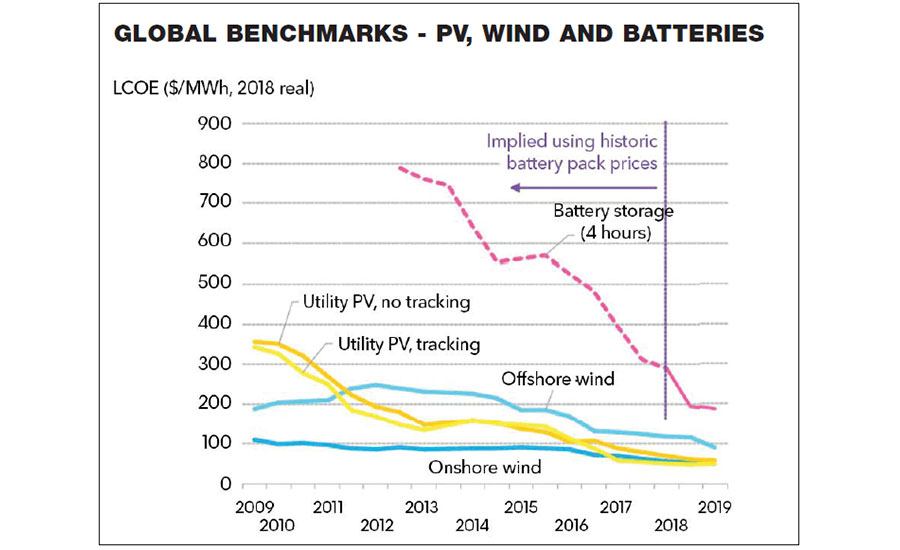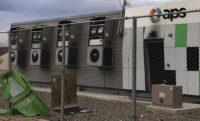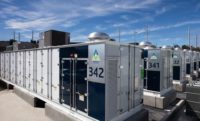Questions are still awaiting answers as Arizona Public Service Co. investigates the cause of an explosion April 19 in a 2-MW/2-MWh grid-connected energy-storage battery facility in Surprise, Ariz. The incident sent eight firefighters and a police officer to the hospital with non-life-threatening injuries, but APS has revealed few of its investigation’s findings despite promising in a June 5 statement that “periodic updates will be posted to report on the process and progress being made.”
The explosion of the lithium-ion (Li-ion) battery bank drew new attention to the flammable battery technology, which has caused spontaneous fires in Boeing airliners and Samsung smart phones in recent years.
“Although we don’t know what happened at APS, it’s very likely it’s all the same challenge,” says George W. Crabtree, director of Argonne National Laboratory’s Joint Center for Energy Storage Research. “If you get the temperature of the Li-ion battery above 150° C, a reaction takes place between the cathode and the electrolyte that doesn’t require any oxygen from the air to proceed, and that reaction releases heat. The heat that’s released heats up the battery further; that makes the reaction go faster, and it’s what they call a ‘thermal runaway.’ That has been the major safety problem with Li-ion batteries. It’s very well known.”
The April 19 incident occurred at the APS McMicken Energy Storage Facility, one of two identical battery banks, each about the size of a shipping container, recently built to help store solar energy to better meet power demand after sunset. The battery systems consist of 27 racks of 14 modules each, for a total of 378 modules of lithium-ion batteries. Construction began on the facilities in 2016 and they came online in 2017.
With more than 1,700 MW of renewable-energy capacity already online, APS continues to invest heavily in solar energy development, including the energy-storage batteries required for round-the-clock load serving. In February 2019, the utility announced plans to add 850 MW of battery storage and at least 100 MW of new solar generation to its system by 2025.
The installation base of grid-connected energy storage was negligible before 2000 and utility industry experience with it has been thin, but there have been only three catastrophic failures at major facilities in the U.S.: one in Hawaii and two in the APS system in Arizona. In 2012, a 1.5-MW APS battery facility near Flagstaff, Ariz., caught fire. The utility took lessons from the investigation of that incident and has continued with advancements in battery design and safety standards to expand its stationary storage for renewable energy resources.
It is still early days for establishing a general incident timeline for this technology according to Ben Kaun, energy storage program manager at the Electric Power Research Institute in Palo Alto, Calif. “We have had discussions with a lot of industry participants about the potential value of developing an incident database, so that we can understand … the kinds of consequences that occur when different types of failures happen,” he told ENR.
“What we’re learning over time is that it’s not necessarily always a battery problem,” Kaun says. “It’s not necessarily that the failures are occurring within the battery. There are other systems that make up an energy storage system, which can result in failures, and those failures can result in further failures of the battery.”
Despite the recorded incidents of bursting into flames, Li-ion batteries now make up 98% to 99% of all new battery-type energy storage systems, and “there’s been rapid adoption in the last couple of years in particular,” says Kaun. Potentially competing technologies “are either not in the right cost point now or are at earlier technology-readiness levels, still in the R&D phase where one might speculate that they could one day take market share from Li-ion,” he says.
A safer technology may be so-called flow batteries, which “operate with liquid anodes and cathodes instead of solid anodes and cathodes that you have in most batteries,” Crabtree says. “The advantage of that for the grid is that if you make the tank 10 times bigger, put 10 times more liquid in it, you store 10 times more energy; it scales perfectly linearly. That is not true of Li-ion.” A recent BloombergNEF report indicates the levelized cost of electricity from batteries has fallen faster than the cost of solar panels. “That could easily happen to flow batteries as they get into high production mode,” he says.





Post a comment to this article
Report Abusive Comment